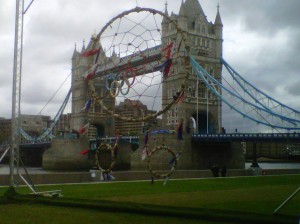
There is no doubt that the London 2012 Games set a ‘high dream’ for embedding sustainability: zero waste, low carbon, 100% public transport, providing real and sustained employment for local people and a community inspired to be more active and healthier. It is easy to stand back and throw stones where things haven’t gone to plan, and it is far more difficult to show leadership when dreams turn to nightmares.
So it was a huge coincidence on the day that I was heading for the US First Minister’s residence to hear about their plans for their new ‘green’ Embassy building, that I came across a giant-sized dream catcher installed right outside City Hall. Dream catchers were first used by US First Nations people as charms to ward off bad dreams – letting only the good dreams through. They were re-appropriated as a potent symbol of First Nations unity in the 1960s & 70s.
Turning good dreams to reality is what good architecture is about and good architecture requires good leadership. The new US Embassy Building promises to reach BREEAM Outstanding and was described by its proud designers as a ‘symbol of transparency’, and ‘almost a crystal on the landscape’ in its new home near Battersea. All hyperbole aside, it has a number of very interesting features: it will look to meet the GLA requirement for 20% of energy being derived from onsite renewables; and its double skin really is truly transparent – a significant shift from the Embassy buildings of generations past. What I liked most about the design was the unique approach to perimeter fencing: rather than putting up an obvious barrier to the public, the site is to be ringed on one side with a lake (that also performs a heat-rejection and cooling function for the building) and that wonderful British thing – the Ha Ha to the north. This soft approach to security demonstrates considerable ingenuity in resolving what is a fundamental juxtaposition: the need to retain an appropriate level of security in these times, while also not alienating the local community with symbols of force and securitisation.
When so much oxygen is being focused on the Games themselves, it is easy to forget that their power to inspire change in wider circles is significant. Not only is the US presence in London been given a greener twist through the new Embassy plans, but its own national team have launched the ‘Green Ring’ initiative. Some time ago we launched a rather oblique shot over the bows of national teams, pleading for more of them to pay some attention to London 2012’s sustainability goals. It is pleasing then to see the US Team committing to a number of concrete measures around energy, greenhouse gas, water and waste across their home base, international travel and training centres. It is for example, the largest single team to commit to offset 100% of their travel to the London 2012 Games.
Also launched on this day of coincidences, was a high profile series by the Lancet on physical activity. It claims that sedentary lifestyles are nearly as dangerous as smoking, with 1 in 10 people dying from sedentary-related causes globally. The news is grim in the context of the UK’s level of sedentariness. With evidence like this, it is difficult to put faith in the so-called ‘festival effect’ of the 2012 Games – the idea that watching sport will somehow inspire people to go out and try it for themselves. In fact, the Lancet series emphasises that social, cultural and environmental factors are critical in getting people to increase their physical activity as part of their everyday lives – it is about peer action, spatial planning and consistent messaging, more than it is about being inspired by the hard work of professional athletes. This is why the behaviour change power of the 2012 Active Travel programme is so crucial – if up to 30% of Londoners include walking or cycling as part of their daily commute during the Games, they may just continue this behaviour afterwards. The power of this mass change in behaviour would be significant.
To avoid the nightmare of ever-increasing sedentary behaviour in the UK, perhaps we need to consider the legacy from the 2012 healthy living dream afresh.
Emma Synnott
July 2012
